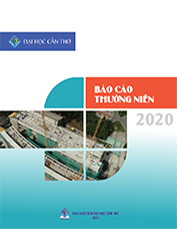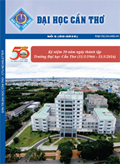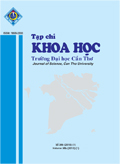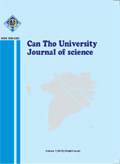Thông tin chung: Ngày nhận: 05/11/2012 Ngày chấp nhận: 22/03/2013 Title: Restricted regimes on alterations of digestive enzyme and nutrient digestibility in striped catfish (Pangasianodon hypophthalmus) fingerlings Từ khóa: Cá tra, ăn gián đoạn, men tiêu hóa, độ tiêu hóa Keywords: Striped catfish, restricted feeding, digestive enzyme, nutrient digestibility | ABSTRACT Studies on the changes of digestive enzyme activity and nutrient digestibility during the mixed feeding schedules of striped catfish (Pangasianodon hypophthalmus) were conducted. Striped catfish fingerlings (15-20 g) were stocked into 12 tanks at a density of 50 fish per tank. Four different mixed feeding schedules were tested on triplicate groups of fingerling fish including (1) fish were fed to apparent satiation twice a day for 5 weeks; (2) satiation for 7 days and starvation for 2 days; (3) satiation for 7 days and starvation for 3 days; and (4) satiation for 7 days and starvation for 4 days. The activity of digestive enzymes (amylase in stomach and intestines; and pepsine in stomach) and the digestibility of feed nutrients of mixed feeding schedules were significantly higher than those of the control group (p<0.05). Therefore, mixed feeding schedules may be recommended as a routine procedure in commercial production of striped catfish fingerlings. This techniques could improve the economical and environmental sustainability in aquaculture production TóM TắT Nghiên cứu về sự thay đổi của men tiêu hóa và độ tiêu hóa dưỡng chất của thức ăn theo chu kỳ cho ăn gián đoạn ở cá tra (Pangasianodon hypophthalmus) giống được tiến hành. Cá tra giống (15-20 g) được thả vào 12 bể với mật độ 50 con/bể. Thí nghiệm được tiến hành với 4 nghiệm thức và 3 lần lặp lại gồm (1) cá được cho ăn theo nhu cầu 2 lần/ngày trong thời gian 5 tuần thí nghiệm; (2) cá được cho ăn theo nhu cầu 7 ngày và ngừng 2 ngày; (3) cá được cho ăn theo nhu cầu 7 ngày và ngừng 3 ngày; (4) cá được cho ăn theo nhu cầu 7 ngày và ngừng 4 ngày. Hoạt tính các men tiêu hóa (amylase trong dạ dày và ruột; và pepsin trong dạ dày) và độ tiêu hóa dưỡng chất thức ăn của cá tra ở nghiệm thức cho ăn gián đoạn cao hơn có ý nghĩa (p<0,05) so với nghiệm thức cá được cho ăn hàng ngày. Kết quả cho thấy, cho ăn gián đoạn làm tăng hiệu quả sử dụng thức ăn thông qua tăng khả năng tiêu hóa thức ăn và tăng các hoạt tính men tiêu hóa, từ đó giảm được chi phí thức ăn và giảm thiểu ô nhiễm môi trường. |






